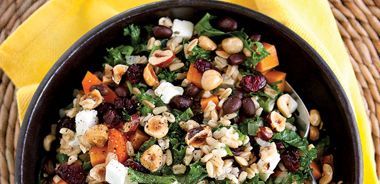Oat and Sweet Potato Salad

You can serve this salad as a main dinner course for a crowd, or toss it together on a lazy Sunday afternoon and you’ll be set for a week’s worth of healthy lunches.
4 tsp (20 mL) grapeseed oil, divided
1 cup (250 mL) oat groats
1 medium onion, diced
2 cups (500 mL) low-sodium vegetable broth
1 lb (450 g) sweet potato, peeled and cubed
2/3 cup (160 mL) roughly chopped hazelnuts
2 medium carrots, finely chopped
2 cups (500 mL) finely sliced kale
1 - 14 oz (396 g) can black beans, drained and rinsed
2/3 cup (160 mL) dried cherries or cranberries
1/2 cup (125 mL) diced feta cheese
1 Tbsp (15 mL) fresh thyme
1/4 cup (60 mL) extra-virgin olive oil
2 Tbsp (30 mL) apple cider vinegar
1 Tbsp (15 mL) honey
1/4 tsp (1 mL) black pepper
1/4 tsp (1 mL) red chili flakes
Heat 2 tsp (10 mL) grapeseed oil in medium-sized saucepan over medium heat. Add groats and cook, stirring often, until toasted, about 3 minutes. Add remaining grapeseed oil and onion; cook for 3 minutes more, stirring often. Add broth, bring to a boil, reduce heat, and simmer covered for 35 minutes, or until groats are tender but still chewy. Drain any excess liquid and let cool.
While oat groats cook, steam sweet potato until tender. In dry skillet over medium heat, toast hazelnuts, shaking the pan occasionally, until browned, about 3 minutes.
In large bowl toss together groats, sweet potato, carrots, kale, black beans, cherries or cranberries, feta, and thyme.
In small bowl, whisk together olive oil, cider vinegar, honey, pepper, and chili flakes. Toss dressing with oat mixture. Serve garnished with hazelnuts.
Serves 8.
Each serving contains: 406 calories; 11 g protein; 19 g total fat (3 g sat. fat, 0 g trans fat); 51 g total carbohydrates (14 g sugars, 10 g fibre); 377 mg sodium
source: "Oats", alive #361, November 2012





